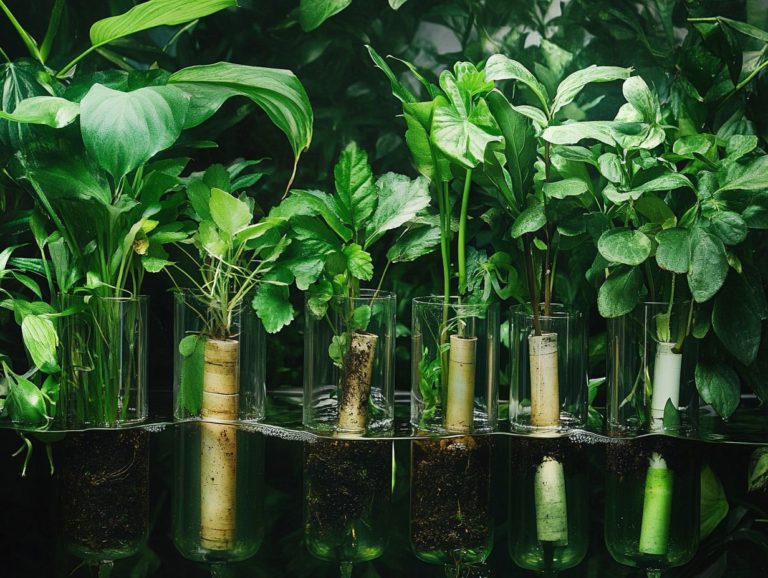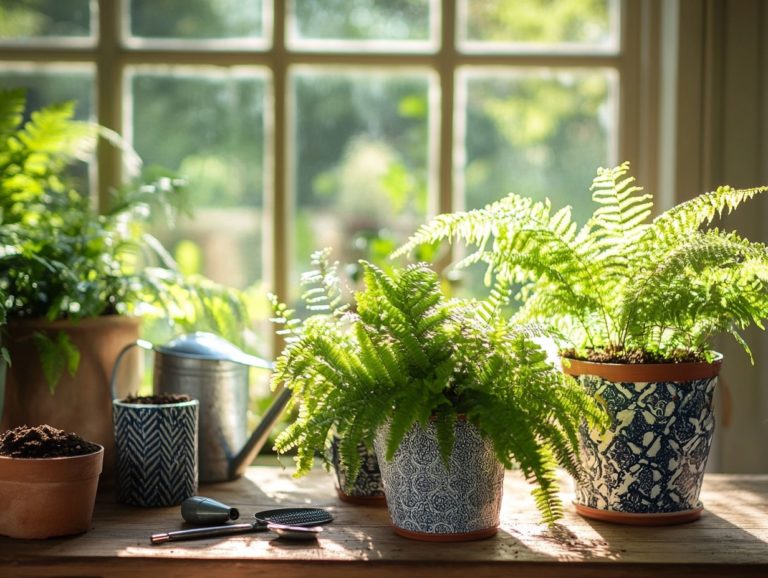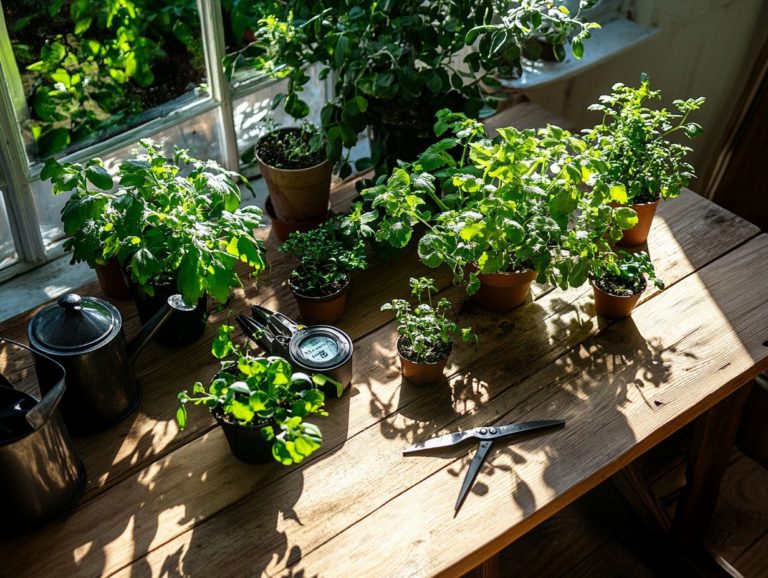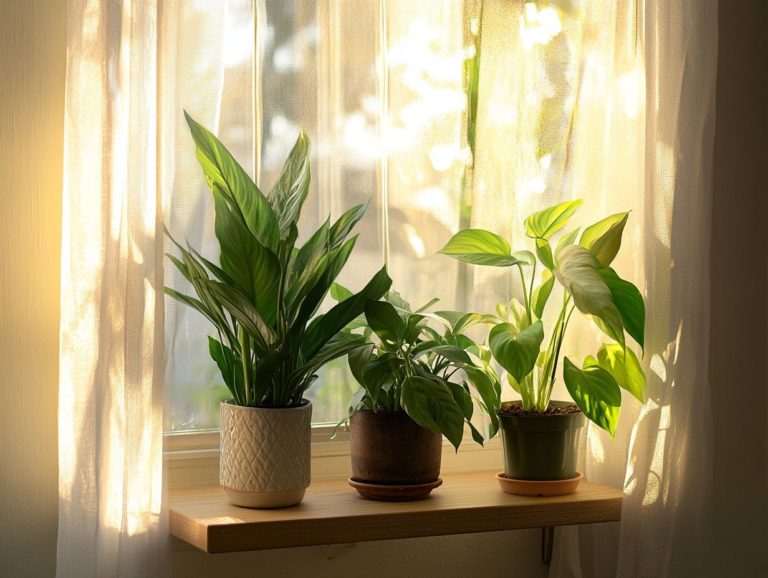How to Monitor Indoor Plants for Health?
Keeping your indoor plants thriving involves more than just the occasional splash of water and a dash of sunlight.
Regular monitoring is essential to ensure your green companions stay healthy and vibrant. This guide delves into the advantages of consistent check-ins, helping you recognize the signs of thriving plants and identify common issues to watch for. You’ll also discover essential tools that can enhance your gardening efforts.
Additionally, you ll find tips for creating an effective monitoring schedule that seamlessly integrates into your routine. With just a few simple observations, you can cultivate a flourishing indoor garden!
Contents
- Key Takeaways:
- Why Monitoring Indoor Plants is Important
- Signs of Healthy Indoor Plants
- Common Issues Affecting Indoor Plants
- Tools for Monitoring Indoor Plants
- Create a Plant Monitoring Schedule
- Frequently Asked Questions
- 1. How do I know if my indoor plants are healthy?
- 2. How often should I water my indoor plants for optimal health?
- 3. What are some common pests that can affect the health of indoor plants?
- 4. Can over-fertilizing harm the health of my indoor plants and lead to root-bound issues?
- 5. How can I improve the air quality for my indoor plants, and what role does humidity control play?
- 6. Are there any tools or apps, like Greensens or Fyta, that can help me monitor the health of my indoor plants?
Key Takeaways:

- Regularly monitoring indoor plants is crucial for their overall health and wellbeing.
- Visual cues, such as vibrant leaf color and sturdy stems, are key signs of a healthy plant.
- Identifying and addressing common issues, like pests and diseases, can help maintain the health of indoor plants.
Why Monitoring Indoor Plants is Important
Monitoring your indoor plants is crucial for maintaining their health and vitality. It enables you to grasp their unique needs, such as best watering needs and the specific moisture levels required for various plant types, like Snake plants, ZZ plants, and Bird of Paradise.
By regularly evaluating these factors, you not only avoid the pitfalls of overwatering and underwatering but also foster healthy growth. Additionally, learning how to recognize indoor plant nutrient needs enhances the overall beauty of your houseplants and elevates the ambiance of your space.
Benefits of Regular Monitoring
Regularly monitoring your indoor plants brings a wealth of benefits, allowing you to maintain their health through informed watering practices and effective pest management, ensuring they thrive beautifully in their environment.
By utilizing tools like a soil moisture meter, you can sidestep the common mistake of overwatering, which often leads to root rot (a condition where roots decay from too much water) and other complications. To enhance your indoor gardening experience, consider checking out what tools you need for indoor plant care. This proactive approach enables you to create a watering schedule that aligns perfectly with your plants’ needs, setting the stage for optimal growth.
Understanding effective pruning techniques can greatly improve your plants’ health by removing dead or diseased leaves. This not only promotes better air circulation but also encourages new growth. To maintain your plants effectively, it’s also beneficial to know what the best tools for indoor plant care are, ensuring your greenery remains vibrant.
Lastly, ensuring that your pots have proper drainage holes is crucial. This helps prevent water accumulation, safeguarding your roots from suffocation and contributing to the overall vitality and longevity of your beloved plants. For more tips, check out best practices for indoor plant care.
Signs of Healthy Indoor Plants
Recognizing the signs of healthy indoor plants is essential for any discerning plant parent. You’ll want to look for key indicators such as vibrant leaf coloration, robust growth patterns, and the ability to thrive under the right humidity and light conditions.
These factors work in harmony to ensure that plants like Snake plants and ZZ plants truly flourish in their environment.
Visual Indicators
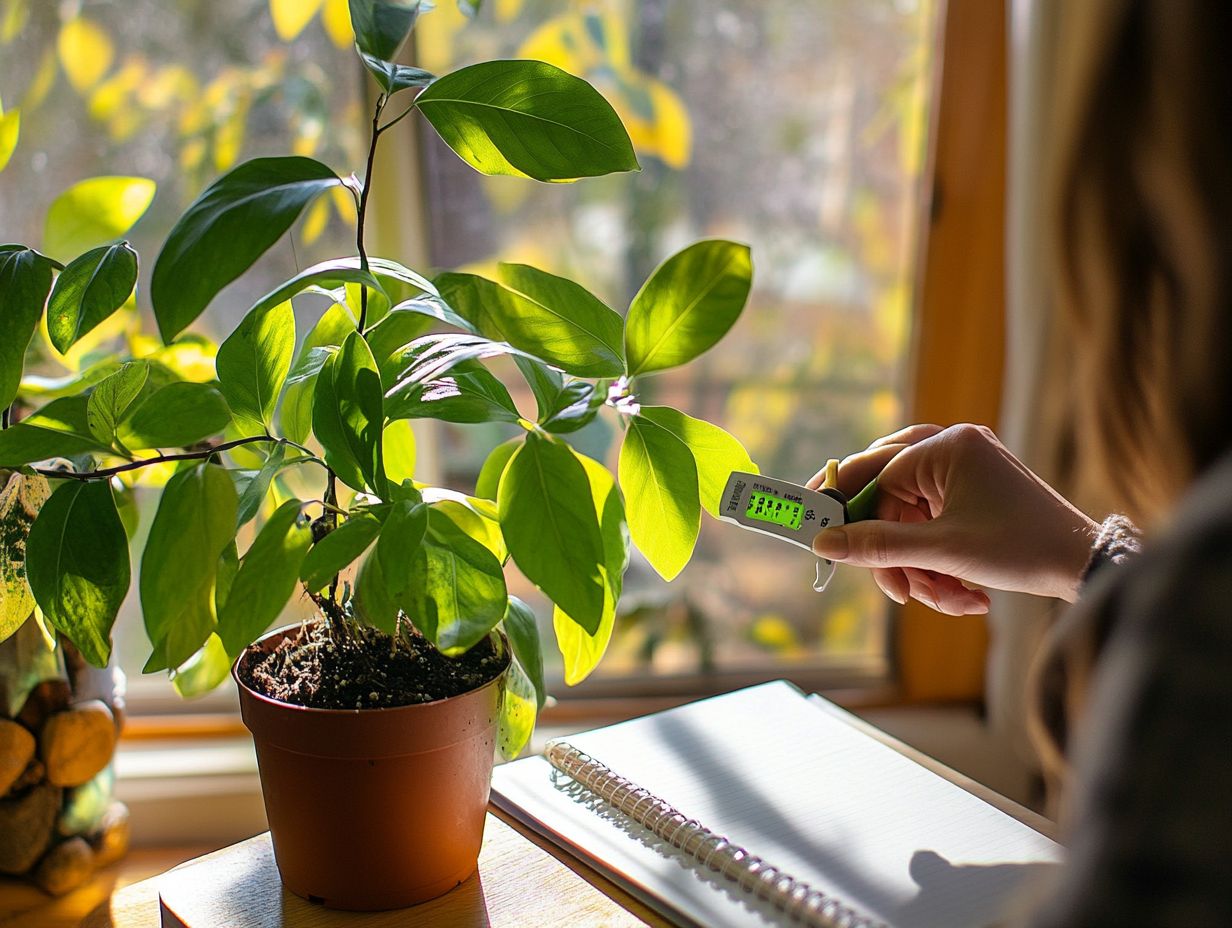
Visual indicators serve as essential markers of plant health. For instance, if you notice vibrant, green leaves or sturdy stems, it s a clear sign that your houseplants are thriving in their decorative pots. Not only do they elevate the aesthetic appeal of your space, but they also provide stress relief just by being there.
Healthy leaves often exhibit a rich emerald hue, indicating that you are providing the right balance of light and moisture. If you see yellowing or wilting, it might be time to reassess your watering habits or sunlight exposure. To ensure optimal moisture levels, consider how to monitor moisture levels in cuttings. Strong, firm stems are typically a sign of proper nutrition and care, while spindly growth could suggest a lack of essential resources.
By keeping an eye on these characteristics, you can create an environment that nurtures your plants and boosts your well-being!
Start monitoring your plants today for a vibrant indoor garden!
Common Issues Affecting Indoor Plants
Indoor plants can face several common challenges, including overwatering, underwatering, and becoming root-bound (when the roots grow too tightly in the pot). If you don t address these issues promptly, they can significantly affect the growth and vitality of your beloved greens.
As a dedicated plant parent, staying vigilant and proactive is essential to ensure your plants thrive.
Identifying and Addressing Problems
Identifying and addressing issues with your indoor plants requires attentive observation and basic gardening skills. Using moisture meters helps determine optimal watering needs, preventing problems like root-bound plants or bothersome insect pests that could hinder growth.
Regularly checking moisture levels streamlines your watering routine and enables early detection of common issues, such as nutrient deficiencies or fungal infections. Additionally, it’s crucial to monitor light exposure for healthy plants by inspecting leaves for discoloration or pests and ensuring adequate drainage, you can greatly enhance the health of your indoor greenery.
Integrating a schedule for routine checks fosters attentive care, leading to a thriving indoor garden that flourishes. This proactive approach not only preserves the aesthetic appeal of your space but also contributes to your household’s overall well-being, making your investment in plant care truly worthwhile. For example, understanding root health in houseplants is crucial for ensuring their vitality.
Tools for Monitoring Indoor Plants
Using the right tools for monitoring your indoor plants is crucial for effective plant care. Tools like soil moisture meters and plant monitors, often equipped with mobile app integration, offer an exceptional user experience.
With these tools, you can ensure your plants thrive and flourish, making your journey as a plant parent both rewarding and enjoyable.
Essential Equipment and Techniques
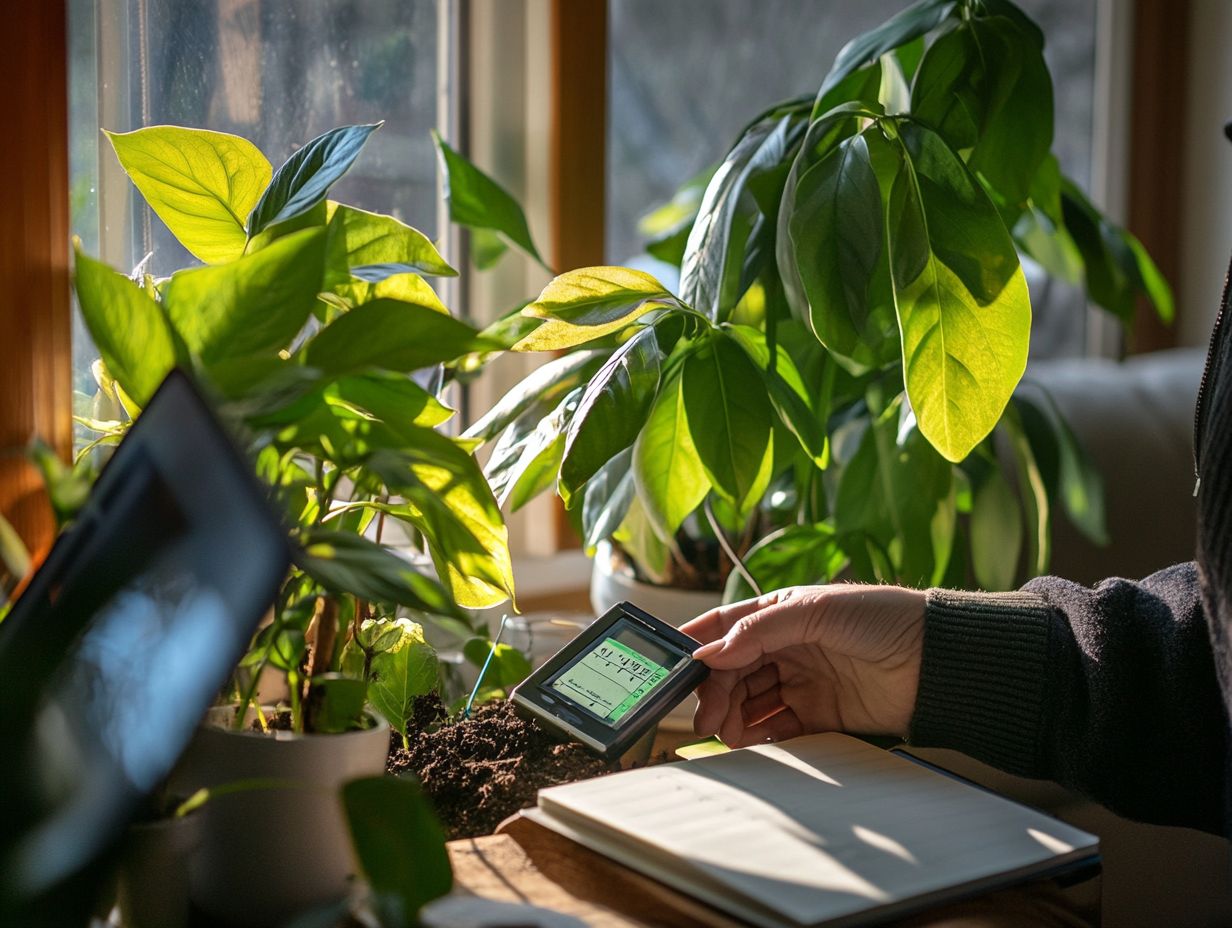
Essential equipment like moisture meters and other gardening gadgets is vital for effective plant care. These tools enable you to track moisture levels and determine the ideal testing frequency that encourages healthy plant growth.
By using these tools, you can avoid the common pitfalls of overwatering or underwatering, ensuring that your indoor plants flourish. Moisture meters vary widely, from simple stick versions to advanced digital models that provide detailed insights. Alongside moisture meters, adding humidity gauges and light meters can enhance your monitoring practices for a well-rounded approach to plant care. To further improve your indoor gardening skills, check out how to test soil quality for indoor plants.
Regularly checking soil moisture levels and adjusting your watering schedule based on these readings creates optimal conditions for root development and overall plant vitality, highlighting the importance of monitoring your indoor plants, resulting in vibrant, healthy foliage.
Create a Plant Monitoring Schedule
Create a plant monitoring schedule to stay on top of your plant care. This approach ensures that each of your houseplants receives the individualized care it requires. It promotes healthier growth and invites you to connect with the gardening community, where you can exchange tips and learn best practices from fellow plant enthusiasts.
Tips for Consistent and Effective Monitoring
To maintain healthy plants, employ consistent and effective monitoring techniques. These practices can greatly enhance the longevity and vitality of your indoor plants while improving your gardening skills.
By regularly checking soil moisture levels, light exposure, and pest activity, you can swiftly identify any issues that arise. A simple watering schedule will help establish a routine, benefiting both your plants health and your understanding of their specific needs.
Keeping a journal to track growth patterns and health milestones provides valuable insights, enabling you to make quick adjustments when necessary. This structured approach leads to knowledge-based decision-making, empowering you to cultivate a thriving indoor garden with confidence.
Check out this video for a deeper understanding of plant care techniques and tips!
Frequently Asked Questions
Have questions? Explore the most common queries related to indoor plant care to enhance your knowledge and skills.
Now, take action using the insights you ve gained! Connect with the gardening community and start nurturing your indoor plants to their fullest potential.
1. How do I know if my indoor plants are healthy?
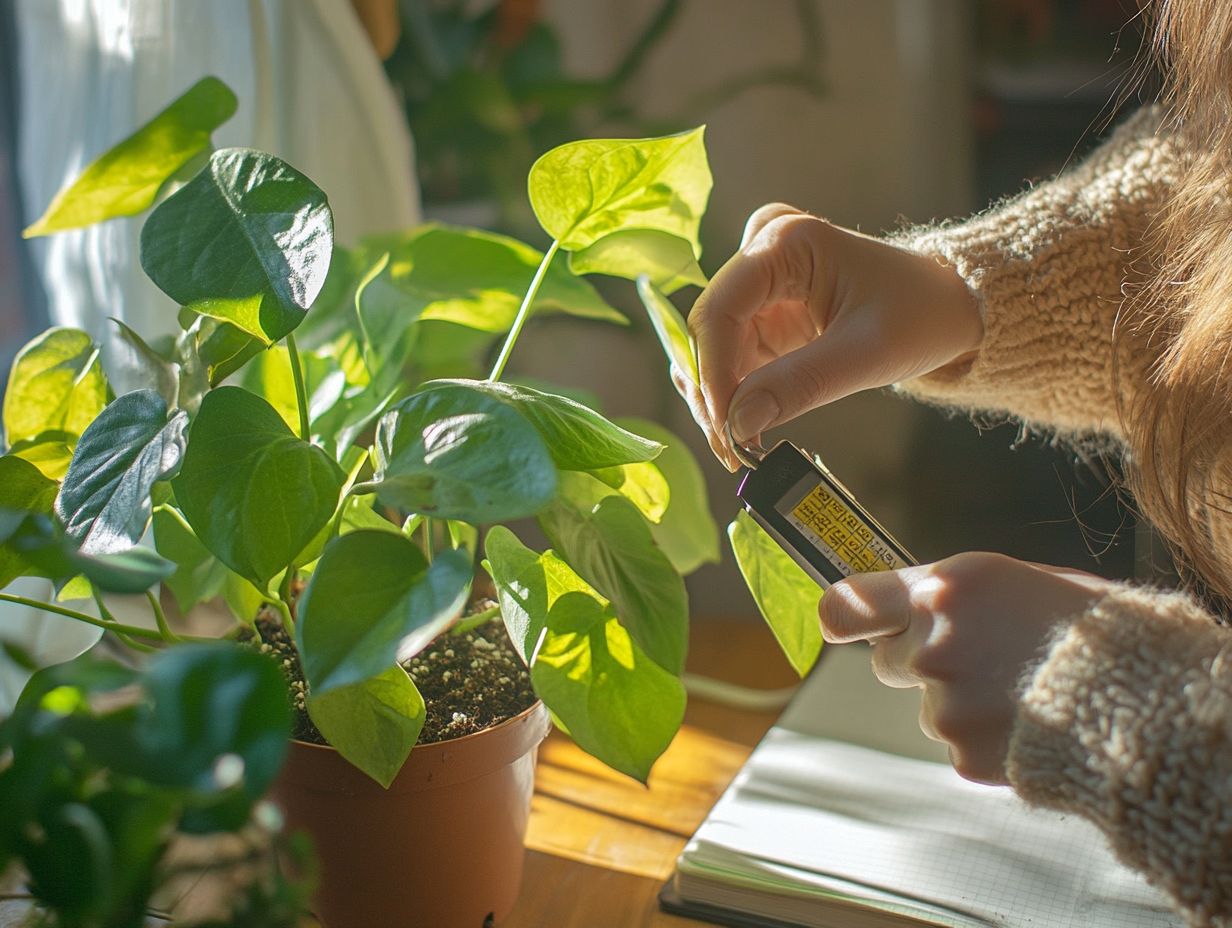
To monitor the health of your indoor plants, check for yellowing or browning leaves, wilting, and insect infestations. Healthy plants have vibrant, green leaves and sturdy stems.
2. How often should I water my indoor plants for optimal health?
The frequency of watering depends on the type and size of your plant, as well as its environment. Monitor the soil moisture and water when it feels dry.
3. What are some common pests that can affect the health of indoor plants?
Common pests that can harm your indoor plants include spider mites, mealybugs, and aphids. Regularly inspect for any signs of pests and treat them promptly.
4. Can over-fertilizing harm the health of my indoor plants and lead to root-bound issues?
Yes, over-fertilizing can harm your indoor plants, including popular ones like Snake plants and ZZ plants. Too much fertilizer can damage the plant, causing leaves to yellow and making it weak against diseases and pests.
5. How can I improve the air quality for my indoor plants, and what role does humidity control play?
Improve the air quality for your indoor plants by using a humidifier to increase humidity. Regularly dust the leaves to remove build-up, and consider techniques that boost humidity and fresh air circulation.
6. Are there any tools or apps, like Greensens or Fyta, that can help me monitor the health of my indoor plants?
Yes, various tools and apps can help monitor your indoor plants’ health. Soil moisture meters and plant sensors provide valuable data, while mobile apps offer customized care instructions for different plant types.


